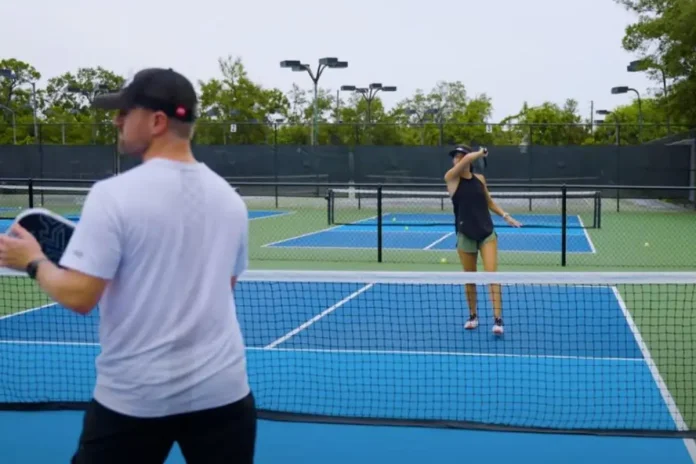Pickleball Kitchen Line Strategy: When your opponent hits a smash in pickleball, it can feel overwhelming. But learning how to read, defend, and counter smashes can turn a dangerous shot into an opportunity. Players who master defensive positioning, soft paddle techniques, and smart shot choices can survive tough rallies and even flip the momentum.
Why Overheads Are Challenging but Manageable
Smashes descend quickly toward the feet and often aim for the body. Many beginners panic, swing wildly, or freeze. However, the pickleball slows after the bounce, giving defenders a chance to absorb pace, reset, and prepare their next shot. The goal is simple: keep the ball in play and regain control of the rally.
Step 1: Read the Smash Early
Recognizing cues before contact is key:
Paddle face: An open or closed paddle signals the angle.
Body position: Aggressive steps often indicate a shot toward the body.
Contact height: High contact usually produces a sharp angle.
Partner signals: If your teammate calls “Back! Middle! Lob!” retreat quickly and coordinate your positioning.
Step 2: Positioning and Footwork
Proper movement gives you time to react:
Back up early: Controlled steps create space. One extra step can make a difference.
Drop-step or side-shuffle: Keeps balance and vision while retreating.
Split-step: Time your jump as the opponent strikes to prepare for lateral or backward movement.
Stay low: Bend your knees, keep the paddle near your feet, and prepare for a dig.
Step 3: Paddle and Body Mechanics
Defensive technique matters more than power:
Soft hands, firm frame: Loosen your grip slightly (≈3/10) and let the ball compress on the paddle.
Open paddle face: A slightly open face absorbs speed and keeps the ball low.
Minimal swing: Think “deflect and place,” not “hit hard.”
Ignore extreme shots: High chest or head-level smashes often fly out; let them go.
Step 4: Defensive Shot Choices
Choosing the right response depends on your situation:
Default reset: Soft block into the kitchen, center or crosscourt. Neutralizes the rally.
Emergency deep-middle lob: Sends the ball high and deep, buying time if pinned or off-balance.
Roll-block: Gentle topspin to deep middle to prevent sharp re-smashes.
Counter-drive: Compact return at the hitter’s body or backhand hip when you read the shot early.
High float: Safe tall ball to opposite corner when jammed; keeps the rally alive.
Step 5: Doubles Coordination
Catherine Parenteau and Rachel Rohrabacher emphasize teamwork:
Stagger back to create a defensive line.
Call shots early for shared awareness.
Cover the middle after a dig and step forward together to reclaim the kitchen.
Avoid crosscourt panic shots; they leave your partner exposed.
Common Mistakes and Fixes
Backpedaling too long: Use drop-step/side-shuffle and split-step.
Standing upright: Bend knees, paddle stays low.
Full swings: Reduce to soft blocks and aim for height, not speed.
One-and-done mindset: Expect multiple smashes; dig two to five in a row.
Targeting corners under pressure: Reset to the kitchen or deep middle first.
Pro Tips and Advanced Reads
Eyes up, paddle low: Beat the ball to your feet.
Read the wrist: Closed paddle face and shoulder turn indicate angled shots; open face signals straighter shots.
Extra step rule: Professionals retreat more to create time and balance before contact.
Drills to Improve Smash Defense
50% Smash Dig Series: Feed 50% overheads to feet; block ten in a row into the kitchen.
Two-Ball Recovery: Smash followed by a second quick ball; reset both before moving forward.
Deep-Middle Lob Escape: Practice defensive lobs when pinned, then advance behind the next drop.
Split-Step Timing: Partner pump-fakes three times before striking; practice split-step on motion.
Grip-Pressure Ladder: Block balls at different grip pressures to feel soft hands versus firm hands.
Half-Court Gauntlet: One attacker, one defender; reset seven balls before attacker reaches eleven winners.
Gear and Environment Adjustments
Paddle balance: Slight head weight helps stabilize blocks.
Grip size and tack: Secure handles allow softer hands without over-gripping.
Shoes: Traction is critical for first steps and controlled stops.
Ball and conditions: Adjust depth for hot balls, wind, and sun; favor deep-middle targets.
Special Cases
Let chest/high shots go long—they often miss.
High, safe floats may be the only option if pinned wide or deep.
Counter-drives are possible when opponents are net-crowding, but only if balanced.
Survive First, Then Attack
Overhead defense in pickleball is about survival. A few clean digs and resets can turn the rally. Focus on staying alive first, then reclaim the kitchen and shift to offense.
Quick Smash Defense Cheat Sheet
Step back early, split-step.
Paddle low, soft hands, open face.
Default: reset to kitchen; emergency: lob deep middle.
Center and depth over pace and corners.
Let extreme shots go long.
Step forward together after a good dig.
News in Brief: Pickleball Kitchen Line Strategy
Learning to defend smashes in pickleball helps players survive and turn rallies around. Key strategies include early retreat, split-step timing, soft hands, and choosing the right defensive shot. Catherine Parenteau and Rachel Rohrabacher emphasize doubles coordination. Proper drills and gear adjustments improve reaction and control, turning defense into offense.
ALSO READ: Unlock Pro Secrets: Dominate the Pickleball Kitchen Line With These Game-Changing Attack Moves

